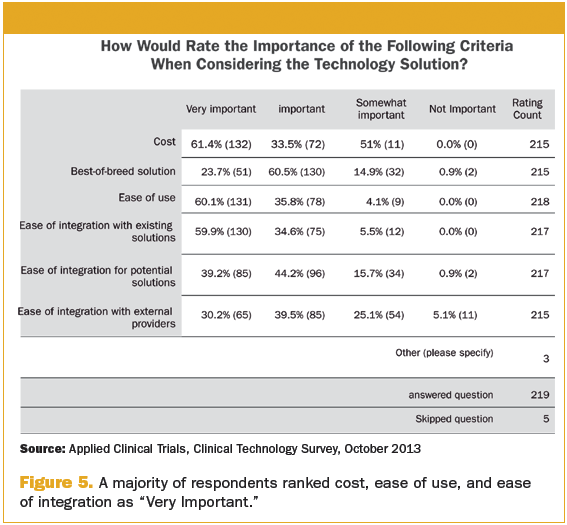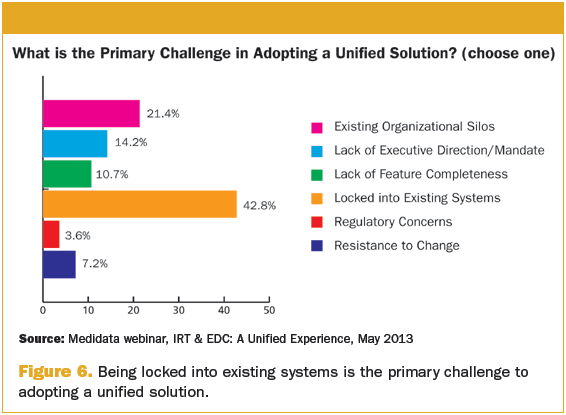Clinical Technologies
As we move towards cloud-based technologies, lingering questions and concerns remain.
From ePRO, to eCRFs, eTMFs, trial management in the form of CTMS, to sophisticated analytics for forecasting, modeling and trending everything from site feasibility to recruitment and budgets...there are not many areas of clinical trials that technology does not touch. But technology brings with it its own set of complications, especially in our current world of outsourcing where sponsors and CROs share data to leverage decision-making and benchmarking.
With this in mind, Applied Clinical Trials and our conference company CBI, producers of ClinTech 2014, surveyed where our audiences are in regard to clinical technologies. We focused on how purchasing decisions are made; integration and maintenance issues; and views of technology providers.
The short history of clinical technologies is that it took EDC approximately 10 years to reach a 70% adoption rate. Even now, EDC may not be the primary data collection source, many trials still use paper—more likely in emerging regions, small trials, and Phase I trials. In the early adoption years, technology providers began adding on those aforementioned "e" technologies, or eClinical, that added to the chain of software services for the clinical research enterprise. Along the way, it became clear that suites from one company weren't as important to industry as best of breed solutions, which led to integration issues coming to the fore.
But also in that time frame, there has been one significant change in the landscape that impacts technology choices—cloud-based solutions or cloud computing. At last year's ClinTech 2013, it was clear that the cloud was the inevitable choice for sponsors making technology decisions, but there was much trepidation in that choice. What about security? What about legacy data? What would the cloud look like in five years?
We asked survey respondents to describe their feelings about cloud-based solutions (Figure 1). Thirty-four percent believe the cloud is a cost-effective solution. But a slightly greater number also find the cloud confusing or not secure.

This opinion piece, http://bit.ly/194UXiW/, written by Rick Morrison, founder of a cloud-based analytics and data collaboration company, appeared on our blog. It provides a simple and understandable outline of the benefits of cloud computing—these include:
- Lower ongoing cost
- No capital expense
- Pay only for what you use
- More secure
- Focus on core competencies
- Scalable
- Quick deployment
Wayne Kubick, technology columnist for Applied Clinical Trials, wrote about the cloud two years ago, which can be accessed here http://bit.ly/HJwutp. Two years later, Kubick observes, "As we approach the end of 2013 the external world in general is certainly flying into the cloud, but much of the world of regulated clinical research is still frequently chained to the ground." He believes that the majority of us access and use cloud applications everyday on smartphones and pads, but there still exists a level of risk aversion, and adherence to legacy regulatory and IT attitudes and that hold industry back. "While these constraints persist within these enterprises, we're seeing the cloud as the platform of choice for collaborative initiatives such as IMI (with its eTRKS translational medicine system) and TransCelerate Biopharma and others. Smaller companies are more likely to make the transition sooner for their internal systems. And there are a number of technology start-ups gambling that the cloud will be the only platform of choice before long. Though old habits die hard, I do foresee the balance tipping within the next three years—it will simply be too difficult to ignore."
And a note on security, both Kubick and Morrison believe that cloud suppliers are more capable of preserving security. Kubick notes that security is absolutely fundamental to their survival and Morrison says they have more experience with computer infrastructure than sponsors, and by virtue of their working with more systems and data, they become security experts more easily than sponsors.
Diving deeper into the cloud, we wanted to look at the profile of those 5% who responded "I Love the Cloud." If you love the cloud, you are 66% more likely to be buying workflow management or document management solution in the next two years. And you are evenly distributed between a purchasing a solution to help with risk-based monitoring, recruitment or study start up at 22.2%. If you love the cloud, cost is very important to you, and ease of integration with existing solutions, potential solutions, and external providers is very important. And your primary resource for finding new solutions is Google search at 40%.
CROs and technology
There are varying thoughts on how clinical technologies vendors can impact the industry. In this column from early this year, http://bit.ly/1864axQ/, Ken Getz reflected on how CROs could be moving the industry forward in innovation and efficiency. From a technological standpoint, he noted, "Leading CROs are aggressively pursuing new and innovative initiatives to facilitate sustainably higher levels of speed and efficiency. They have introduced a number of eClinical solutions designed to simplify and optimize data and project management and to coordinate disparate technologies." Perceptive Informatic's (Parexel) launch of the MyTRIALS platform and ICON's launch of ICONIK are two such examples.
Other initiatives Getz described use technology solutions to optimize investigative site performance include Covance's Xcellerate methodology and ICON's Firecrest Clinical.
In this piece, http://bit.ly/I1prg6/, published in April of this year, Graham Bunn, PhD, Vice President, Partnerships at Perceptive Informatics, takes the position that as sponsor and CRO partnerships increase and sponsors leave more of the management of trials to their outsourced partners, they should also leave the technology decisions to the CROs. By giving up the requirements for multiple technologies, CROs can gain their own efficiencies in the process. "This change in approach by sponsors has changed the way technology vendors work with their CRO customers. Some large technology vendors have developed a CRO partner program to better serve this segment of the industry, and in the process provided benefits to both the CRO as well as the sponsor. Vendors have implemented strictly controlled, high quality training and testing programs along with user testing (certification), company accreditation and associated branding to recognize high quality CRO partners who are familiar with their technology. This not only enables the CRO to differentiate themselves in the marketplace, but also allows sponsors to feel confident that their strategic CRO partner is correctly qualified and supported throughout the contract duration."

In our survey, 35.8% of the respondents work for a biopharmaceutical company and 20.3% CROs (Figure 2). We asked: "What is your current model with external partners?" (Figure 3) the majority of the respondents said "plug and play by capabilities/functions with multiple providers." This was followed by vendor collaboration to develop a single solution; and a close tie between sole CRO provides an eClinical suite to meet your needs and sole CRO provider, using a data integration platform to utilize any software vendor.

The second choice refers to reports that pharma companies are asking different vendors to collaborate with each other to come up with one solution that meets their needs. In that way, the pharma company doesn't end up using both services that don't completely meet all their needs or they end up paying for portions that they don't want or need.
Criteria for Solutions
When choosing a technology solutions provider, what criteria was most important? Responsiveness to business needs and cost were closely rated as Very Important by our respondents at 69.4% and 63.8% respectively. Reputation in the market was rated Important by 48.9% of the majority.

How respondents discover new solutions is mostly through colleagues and word of mouth, at 34.9% (Figure 4). But the criteria for choosing the vendor—not the solution—is more closely aligned. Respondents list cost, ease of use and ease of integration with existing solutions as very important, all hovering around 60% (respondents were allowed to choose three criteria). Under Important, best of breed solutions won out, followed by ease of integration for potential solutions. A word or two about integration. In our survey, 39% of the respondents noted that technology integration was their biggest challenge (Figure 5). At two recent CBI conferences, integration issues did come into discussion. And not that there is an "integration" backlash, however, some caution that not every solution need be integrated. Much like metrics, thought around what truly will add value by being integrated should be assessed. In addition, even if, for example, a CRO and sponsor enter into a partnership, which will inadvertently call for some level of data sharing, just because two entities may use the same vendor solution doesn't ensure an easier integration. Johann Proeve, Head Global Data Management at Bayer Healthcare, discussed its data management partnership with Covance at CBI's Sponsor and CRO Business Process Systems and Integration conference. He noted that even though both companies use Medidata's Rave as their EDC, these systems are highly configurable—and customized to their needs—so integration is not necessarily a seamless activity.

And there are other challenges to integration or solutions unification, which came up during a webinar about Medidata's IRT and EDC solution (Figure 6). These challenges resonate with Kubick's overall cloud challenges above.

But it is true that the respondents to our survey think that integration is important—either with existing solutions, potential future solutions or with their external providers.
Our respondents said top areas they are planning to purchase solutions in the next two years are risk-based monitoring, workflow management/document management, and study start up. For trends, respondents rate mobile technologies as the only "must-have" technology—other choices were big data, EHR integration, investigator portals and clinical trial supply management.
If we are to agree with Wayne Kubick, that the tipping point into cloud computing is only three years away, then more and more companies will need information on these technologies. Applied Clinical Trials will be the lead media partner on CBI's ClinTech 2014 conference, which will address these topics, and we will continue to feature articles, news and more about clinical technologies in our ClinTech section on our website at www.appliedclinicaltrialsonline.com/ClinTech/ .
